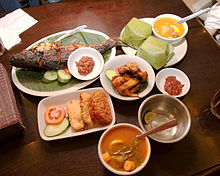Culture
Main article: Culture of Indonesia
Indonesia has about 300 ethnic groups, each with cultural identities developed over centuries, and influenced by Indian, Arabic, Chinese, and European sources. Traditional Javanese and Balinese dances, for example, contain aspects of Hindu culture and mythology, as dowayang kulit (shadow puppet) performances. Textiles such as batik, ikat, ulos and songket are created across Indonesia in styles that vary by region. The most dominant influences on Indonesian architecture have traditionally been Indian; however, Chinese, Arab, and European architectural influences have been significant.
Indonesian cuisine varies by region and is based on Chinese, European, Middle Eastern, and Indian precedents.[183] Rice is the mainstaple food and is served with side dishes of meat and vegetables. Spices (notably chili), coconut milk, fish and chicken are fundamental ingredients.[184] Indonesian traditional music includes gamelan and keroncong. The Indonesian film industry's popularity peaked in the 1980s and dominated cinemas in Indonesia,[185] although it declined significantly in the early 1990s.[186] Between 2000 and 2005, the number of Indonesian films released each year has steadily increased.[185]
The oldest evidence of writing in Indonesia is a series of Sanskrit inscriptions dated to the 5th century. Important figures in modern Indonesian literature include: Dutch author Multatuli, who criticised treatment of the Indonesians under Dutch colonial rule; SumatransMuhammad Yamin and Hamka, who were influential pre-independence nationalist writers and politicians;[187] and proletarian writerPramoedya Ananta Toer, Indonesia's most famous novelist.[188][189] Many of Indonesia's peoples have strongly rooted oral traditions, which help to define and preserve their cultural identities.[190]
Media freedom in Indonesia increased considerably after the end of President Suharto's rule, during which the now-defunct Ministry of Information monitored and controlled domestic media, and restricted foreign media.[191] The TV market includes ten national commercial networks, and provincial networks that compete with public TVRI. Private radio stations carry their own news bulletins and foreign broadcasters supply programs. At a reported 25 million users in 2008,[192] Internet usage was estimated at 12.5% in September 2009.[193]More than 30 million cell phones are sold in Indonesia each year, and 27% of them are local brands.[194]
source wikipedia



No comments:
Post a Comment